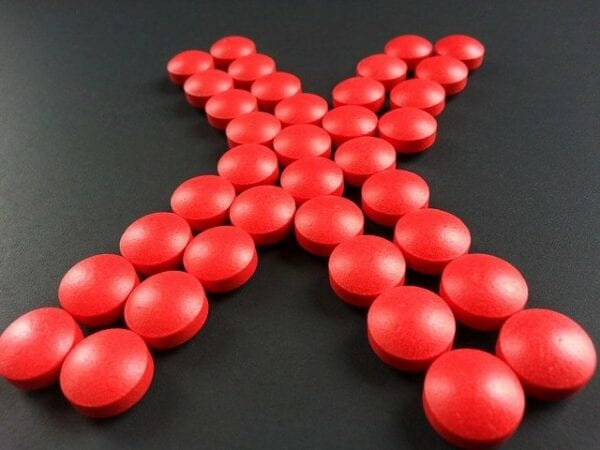Oral iron supplements (podcast) are the cheapest and most effective treatment for iron deficiency anemia. Iron deficiency anemia can occur commonly in infants and women with menorrhagia. For most cases of iron deficiency, oral iron supplementation is sufficient. Occasionally intravenous iron may be necessary if oral iron is insufficient or not tolerated. Older adults are more likely to have constipation from oral iron supplements, which may result in needing to use intravenous therapy instead. We have covered IV iron preparations previously. In this article, we will provide a comparison of oral iron preparations.
Traditionally, oral iron supplements have been dosed as 150-200mg elemental iron daily, such as 3 tablets of 325mg ferrous sulfate daily. Increasing evidence has come out that using high doses of iron may actually paradoxically decrease iron absorption and increase side effects without improving iron levels. The decrease in iron absorption with high daily doses is thought to be due to an increase in hepcidin levels. Due to these findings, it is becoming increasingly more common to dose iron every other day compared to daily dosing, which has the possibility of increased absorption. It is typically not necessary to dose iron more than once daily. The CDC recommends 60-120mg of elemental iron daily.
A common practice that some clinicians will try is to recommend taking iron supplements along with ascorbic acid, due to the possibility that ascorbic acid may increase absorption of iron by causing a lower pH in the stomach. However, some studies do not show any benefit of low pH on iron absorption. More data is necessary to recommend the use of ascorbic acid along with iron supplementation.
In general, there is no evidence that any particular oral iron product is more effective or has fewer side effects than another. Oral iron-containing ferrous salts such as ferrous sulfate, ferrous gluconate, and ferrous fumarate are most common. Overall, ferrous sulfate is the least expensive option and the most commonly used oral iron supplement. Polysaccharide-iron complex is another type of oral iron, available as products such as NovaFerrum with 50mg of elemental iron in each tablet. Polysaccharide iron complex may have fewer GI side effects compared to ferrous salts. However, a small randomized trial of children <12 years old found that ferrous sulfate was slightly more effective than polysaccharide iron complex.
Ideally, iron should not be given with food, especially calcium-containing foods, due to possible impaired absorption. In practice, however, many will recommend doing this if patients have difficulty with iron preparations causing stomach upset. Absorption can also be reduced by agents that reduce gastric acidity, such as antacids, PPIs, or histamine receptor blockers. It is recommended that iron be taken 2 hours before or 4 hours after antacids. Here’s a table with a comparison of oral iron preparations.
| Oral Iron Product | Ferrous gluconate | Ferrous sulfate | Ferrous fumarate | Polysaccharide Iron Complex |
| Strength | 240mg tablet (27mg elemental) 324 mg tablet (38mg elemental) 325mg tablet (36mg elemental) | 325mg tablet (65mg elemental) 220/5mg oral elixir (44mg elemental/5mL) 75mg/mL oral solution (15mg elemental/mL) | 324 or 325mg tablet (106mg elemental) | Various tablet formulations NovaFerrum 50 tablets (50mg elemental) 15mg/mL solution (15mg elemental iron/mL) |
| Cost | $ | $ | $ | $ |
| Comments | Lower concentration of elemental iron | Most common | May be more dangerous in overdose due to the high concentration of elemental iron in each tablet |
- 30 medication mistakes PDF
- 18+ Page Drug Interaction PDF
- 10 Commandments of Polypharmacy Webinar based on my experiences in clinical practice
The article was written by Melody Grafton in collaboration with Eric Christianson, PharmD, BCGP, BCPS
Study Materials and Resources For Healthcare Professionals and Students – Amazon Books
Sources
- Zariwala MG, Somavarapu S, Farnaud S, Renshaw D. Comparison study of oral iron preparations using a human intestinal model. Sci Pharm. 2013;81(4):1123-1139. Published 2013 Jun 21. doi:10.3797/scipharm.1304-03
- Auerbach, Michael, Treatment of iron deficiency anemia in adults. In: UpToDate, Post, TW (Ed), UpToDate, Waltham, MA, 2021.
- Wu TW, Tsai FP. Comparison of the Therapeutic Effects and Side Effects of Oral Iron Supplements in Iron Deficiency Anemia. Drug Res (Stuttg). 2016 May;66(5):257-61. doi: 10.1055/s-0035-1569326. Epub 2015 Dec 23. PMID: 26697889.
- Fei, Cindy. Iron Deficiency Anemia: A Guide to Oral Iron Supplements. Clinical Correlations. March 26, 2015. Accessed April 10, 2021.
- A Physician’s Guide to Oral Iron Supplements. Society for the Advancement of Blood Management. December 2018. Accessed April 10, 2021.
- Iron. Fact Sheet for Health Professionals. National Institute of Health. Nih.gov. Updated March 30, 2021. Accessed April 10, 2021.
- Manoguerra AS, Erdman AR, Booze LL, Christianson G, Wax PM, Scharman EJ, Woolf AD, Chyka PA, Keyes DC, Olson KR, Caravati EM, Troutman WG. Iron ingestion: an evidence-based consensus guideline for out-of-hospital management. Clin Toxicol (Phila). 2005;43(6):553-70. doi: 10.1081/clt-200068842. PMID: 16255338.
- Yvette, Terrie. Iron Supplementation may be Warranted in Some Patients to Build up Iron Stores. Pharmacy Times. June 2014, Women’s Health, Volume 80, issue 6.



Thank you for another informative article! I always enjoy reading them to get different insights with evolving practice. I was hoping to get your insight or thoughts on the use of “heme iron” such as Proferrin in comparison to these iron preparations.